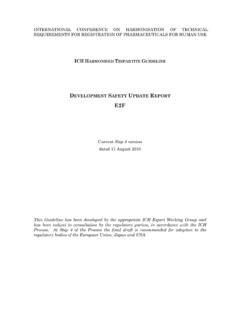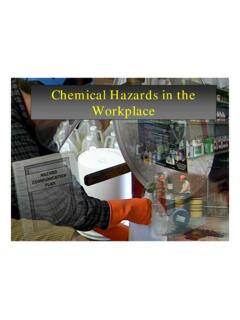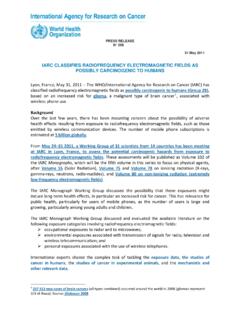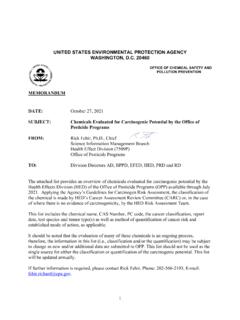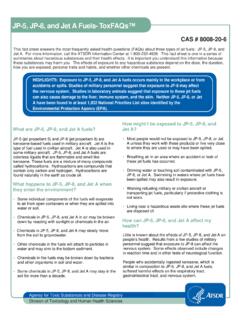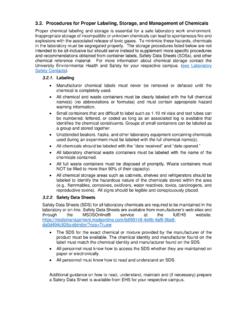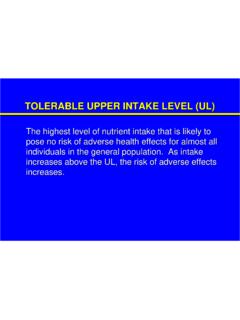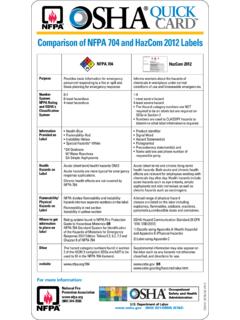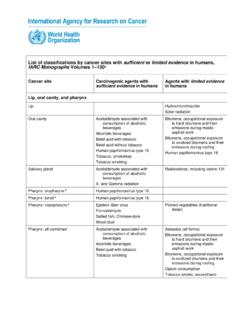Transcription of ADDENDUM TO THE GUIDELINE ON TESTING FOR …
1 INTERNATIONAL COUNCIL FOR HARMONISATION OF TECHNICAL REQUIREMENTS FOR PHARMACEUTICALS FOR HUMAN USE ICH HARMONISED GUIDELINE ADDENDUM TO THE GUIDELINE ON TESTING FOR CARCINOGENICITY OF PHARMACEUTICALS S1B(R1) Draft version Endorsed on 10 May 2021 Currently under public consultation At Step 2 of the ICH Process, a consensus draft text or GUIDELINE , agreed by the appropriate ICH Expert Working Group, is transmitted by the ICH Assembly to the regulatory authorities of the ICH regions for internal and external consultation, according to national or regional procedures. S1B(R1) Document History Code History Date S1B(R1)* Endorsement by the Members of the ICH Assembly under Step 2 and release for public consultation. 10 May 2021 *This ADDENDUM is complementary to the S1 guidelines (S1A, S1B and S1C(R2)) and is not intended to replace the existing S1B GUIDELINE .
2 At Step 4 of the ICH process, this ADDENDUM will be integrated with the S1B GUIDELINE . Legal notice: This document is protected by copyright and may, with the exception of the ICH logo, be used, reproduced, incorporated into other works, adapted, modified, translated or distributed under a public license provided that ICH's copyright in the document is acknowledged at all times. In case of any adaption, modification or translation of the document, reasonable steps must be taken to clearly label, demarcate or otherwise identify that changes were made to or based on the original document. Any impression that the adaption, modification or translation of the original document is endorsed or sponsored by the ICH must be avoided.
3 The document is provided "as is" without warranty of any kind. In no event shall the ICH or the authors of the original document be liable for any claim, damages or other liability arising from the use of the document. The above-mentioned permissions do not apply to content supplied by third parties. Therefore, for documents where the copyright vests in a third party, permission for reproduction must be obtained from this copyright holder. i ICH HARMONISED GUIDELINE ADDENDUM TO THE GUIDELINE ON TESTING FOR CARCINOGENICITY OF PHARMACEUTICALS ICH S1B(R1) ICH Consensus GUIDELINE TABLE OF CONTENTS PREAMBLE ..1 1. INTRODUCTION .. 1 Scope of the ADDENDUM .. 1 Purpose of the ADDENDUM .. 1 Background .. 1 2. A WEIGHT OF EVIDENCE APPROACH TO ASSESS THE HUMAN CARCINOGENIC POTENTIAL OF SMALL MOLECULE PHARMACEUTICALS.
4 2 Factors to Consider for a WoE Assessment .. 3 Integration of WoE Factors for Assessing Human Carcinogenic Risk .. 4 Mouse Carcinogenicity Studies .. 4 3. CLARIFICATION OF CRITERIA FOR SELECTION OF HIGH DOSE FOR RASH2-TG MOUSE CARCINOGENICITY STUDIES .. 5 REFERENCES .. 5 APPENDIX 1: CASE STUDIES APPLYING THE WEIGHT OF EVIDENCE ICH S1B(R1) GUIDELINE 1 PREAMBLE 1 This ADDENDUM is to be used in close conjunction with ICH S1A GUIDELINE on the Need for 2 Carcinogenicity Studies for Pharmaceuticals, S1B TESTING for Carcinogenicity of 3 Pharmaceuticals, and S1C(R2) Dose Selection for Carcinogenicity Studies. The ADDENDUM is 4 complementary to the S1 guidelines . 5 1. INTRODUCTION 6 Scope of the ADDENDUM 7 This ADDENDUM covers all small molecule pharmaceuticals where carcinogenicity evaluations 8 are recommended as described in S1A.
5 9 Purpose of the ADDENDUM 10 This ADDENDUM expands the TESTING scheme for assessing human carcinogenic risk of small 11 molecule pharmaceuticals by introducing an additional approach that is not described in the 12 original S1B GUIDELINE . This is an integrative approach that provides specific weight of 13 evidence [WoE] criteria that inform whether or not a 2-year rat study adds value in completing 14 a human carcinogenicity risk assessment. The ADDENDUM also adds a plasma exposure ratio-15 based approach for setting the high dose in the rasH2-Tg mouse model,1 while all other aspects 16 of the recommendations for high dose selection in S1C(R2) GUIDELINE would still apply. 17 Application of this integrative approach would reduce the use of animals in accordance with the 18 3Rs (reduce/refine/replace) principles, and shift resources to focus onto generating more 19 scientific mechanism-based carcinogenicity assessments, while promoting safe and ethical 20 development of new small molecule pharmaceuticals.
6 21 Background 22 While the S1B GUIDELINE calls for flexibility in considering approaches to address 23 pharmaceutical carcinogenicity TESTING , the basic scheme generally recommends a long-term 24 rodent study which, in practice, is usually a 2-year study in rats, along with a second rodent 25 carcinogenicity study in mice (2-year or short-term study). Since publication of the ICH S1B 26 GUIDELINE , scientific advances toward elucidation of mechanisms of tumorigenic action, greater 27 understanding of the limitations of rodent models, and several retrospective analyses of 28 pharmaceutical datasets indicate that 2-year rat carcinogenicity studies might not add value to 29 human carcinogenicity risk assessment in some cases and the carcinogenic potential could have 30 1 The rasH2-Tg mouse was developed in the laboratory of Tatsuji Nomura of the Central Institute for Experimental Animals (1).
7 The model is referred to in the S1B GUIDELINE as the TgHras2 transgenic mouse. The official nomenclature for the model is CByB6F1-Tg(HRAS)2 Jic which is maintained by intercrossing C57BL/6 JJic-Tg(HRAS)2 Jic hemizygous male mice with BALB/cByJJic female mice. The littermates derived from these intercrosses are the transgenic rasH2-Tg animals with the tg/wt genotype, and the wild type rasH2-Wt animals with a wt/wt genotype. Since other short-term models mentioned in S1B have not gained significant use compared to rasH2-Tg over the past 20 years, pharmaceutical development experience with these models is far more limited. Therefore, other short-term carcinogenicity models referred to in S1B would not qualify for a plasma exposure ratio-based high dose selection.
8 It is appropriate to use wild-type rasH2-Wt littermates of rasH2-Tg mice for dose range-finding studies and for generating exposure data. ICH S1B(R1) GUIDELINE 2 been assessed adequately based on a comprehensive assessment of all available 31 pharmacological, biological, and toxicological data (2-9). 32 To determine whether the conclusions from these retrospective analyses could be confirmed in 33 a real- world setting ( , prior to knowledge of the 2-year rat carcinogenicity study outcomes), 34 an independent international prospective study was conducted under ICH S1(R1) RND 35 Proposed Change to Rodent Carcinogenicity TESTING of Pharmaceuticals Regulatory Notice 36 Document. The conclusion from this prospective evaluation confirmed that an integrated WoE 37 approach could be used to adequately assess the human carcinogenic risk for certain 38 pharmaceuticals in lieu of conducting a 2-year rat 39 In addition, an exposure ratio endpoint (based on animal to human plasma AUC) for high dose 40 selection in 2-year rodent studies as per ICH S1C(R2) has not been globally accepted for use 41 in the rasH2-Tg mouse study.
9 Therefore, a comprehensive analysis was conducted to assess 42 exposures and outcomes in rasH2-Tg studies from available As described in 43 Section 3, the results of this analysis indicate that there is no value in exceeding a 50-fold 44 exposure ratio for high dose selection in this model. 45 2. A WEIGHT OF EVIDENCE APPROACH TO ASSESS THE HUMAN 46 CARCINOGENIC POTENTIAL OF SMALL MOLECULE PHARMACEUTICALS 47 Over the course of drug development, it is important for sponsors to develop a scientifically 48 robust strategy for carcinogenicity assessment that considers key biologic, pharmacologic, and 49 toxicologic information. The integrative WoE assessment approach described in sections 50 and may support a conclusion that the test compound is either: 51 likely to be carcinogenic in humans such that the product would be labeled accordingly 52 and any 2-year rat carcinogenicity studies would not add value; or 53 likely not to be carcinogenic in humans such that a 2-year rat study would not add value 54 (may also not be carcinogenic in rats, or may likely be carcinogenic in rats but through 55 2 Conduct and results of the prospective study will be summarized; ICH Website of RND and PEP updates will be cited; and future DRA manuscript pointed to.)
10 These new citations will appear in the Step 4 Version and this footnote modified. 3 The approach taken for determining an adequate exposure margin for high dose selection for the rasH2-Tg short-term model is similar to that described previously for the 2-year rat and mouse studies (10,11) and Hisada S, Tsubota K, et al (Manuscript in preparation) Survey of Available Data to Assess Tumorigenic Sensitivity of rasH2-Tg Mice and 2-year Rodent Models. Draft Summary: Results were analyzed from studies conducted for 50 drugs in the 6-month rasH2-Tg model and the 2-year rat, 15 of which were also evaluated in the 2-year mouse. For 13 studies concluded to be positive in rasH2-Tg, 6 genotoxic carcinogens were positive within - 3-fold of the AUC exposure ratio or body surface area adjusted dose ratio (rodent:human), and 7 nongenotoxic carcinogens were positive all within 1 - 50-fold.
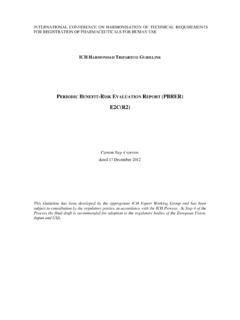
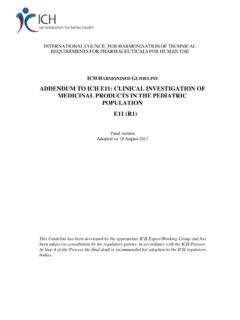
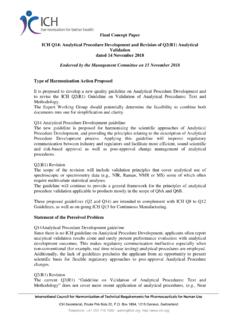
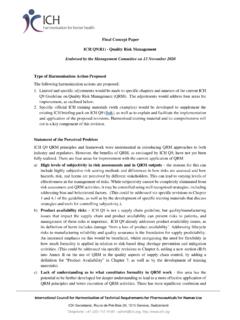
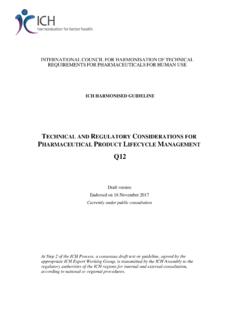
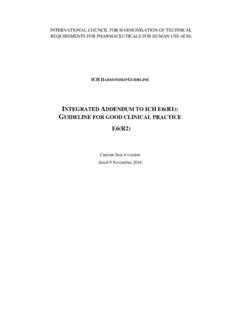
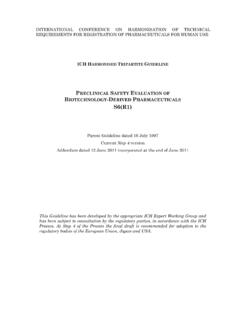
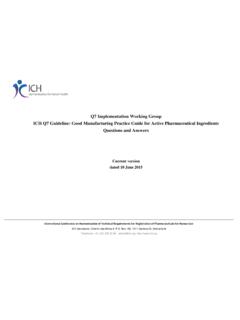
![[ICH E2F] [EXAMPLE DSUR – PHASE III INVESTIGATIONAL …](/cache/preview/e/7/a/2/e/6/3/0/thumb-e7a2e63043c4463724e748eb98faa3a7.jpg)
